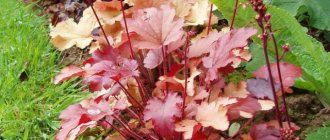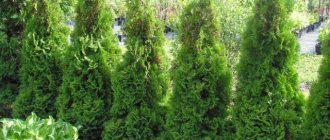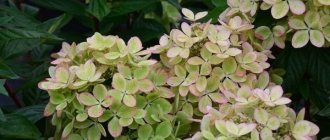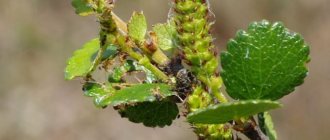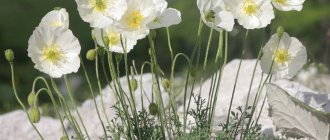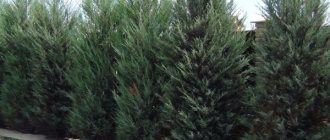Description and characteristics of the variety
This variety of heuchera was named after the German scientist and botanist of the 18th century - Heuchera I.G.
In the wild, as a rule, it grows on mountain slopes, where the concentration of nutrients in the soil is negligible. Heuchera Lime Marmalade is one of the tallest, the height of an adult plant can reach 45 cm. The leaves have different colors, the surface is corrugated, from spring to autumn you can contemplate various shades - from green to bright coral. During flowering, inconspicuous white inflorescences are formed. Lush flowering is observed for two months - from June to August. Grows readily in sunny areas protected from drafts.
Heuchera Marmaladez
Note! The plant is unpretentious in care and easy to care for. Drought and frost resistance indicators are good
It is resistant to diseases and pests. The only thing the plant does not tolerate is excessive waterlogging. To preserve decorative features, it is necessary to carry out rejuvenating division of the bush at intervals of 3-5 years.
Drought and frost resistance indicators are good. It is resistant to diseases and pests. The only thing the plant does not tolerate is excessive waterlogging. To preserve its decorative features, it is necessary to carry out rejuvenating division of the bush at intervals of 3-5 years.
Description Heuchera Caramel
Heuchera variety Caramel is a low-growing, about 20 - 30 cm in height, dome-shaped bush, completely covered with large, attractive leaves of a golden-copper hue. Appearing in the spring, the basal leaves of the crop have a reddish tint, but gradually, by summer, they lighten and become intensely golden on top, and matte carmine on the inside. At the same time, they become pubescent, and by autumn they gradually change color to a more intense one. Heuchera blooms in June-July with small, pale pink flowers, which are collected in paniculate inflorescences and located on long, erect peduncles. However, it is valued not so much for its modest flowering, but for the decorative appearance of the bush, abundantly covered with caramel, brightly colored leaves.
The new hybrid variety of heuchera Mega Caramel amazes with its large dimensions. It reaches a height of 50 cm, the leaves are twice the size of standard ones, as are the giant flower stalks with numerous bell flowers.
Reproduction methods
Heucherella can be propagated in two ways: cuttings and dividing the rhizome. It cannot be grown from seeds. Like most hybrids, this plant produces flowers but does not form fruits with seeds.
Dividing the bush
This plant is divided regularly: once every 3 or 4 years. If you neglect this procedure, then soon the overgrown bush will lose its attractiveness. So, its shoots will begin to actively stretch, and their tops will dry out.
It is recommended to replant and divide the bush from mid to late July or in the first days of August. At this time, the bushes fade, and their roots begin to actively grow. Bushes transplanted at the end of the summer will have time to take root well before the onset of frost.
After the plant is removed from the ground, you must:
- rinse its roots thoroughly;
- cut off all dried shoots;
- divide the bush into parts, of which there may be several.
Please note that each division must have a healthy bud. When planting bushes in open ground, a distance of 0.2–0.3 m is maintained between them. If the divisions are too small, then they are first planted in small pots. And after they get stronger and grow, they can be planted in open ground.
Cuttings
To prepare cuttings, young shoots that appear in spring are used. Cuttings can be cut already in the first days of April. The prepared sections must be placed in a container filled with water, which is mixed in advance with Kornevin. As a rule, the roots of cuttings grow after 25–30 days. As soon as this happens, the pieces are planted in pots filled with fertile substrate.
A young bush is transplanted into the garden only when it begins to actively grow and young leaf blades are formed. The bush adapts very quickly to new conditions. If the seedling was transplanted into open ground in late autumn, then it will need good shelter, to create which you can use fallen leaves and needles, straw or covering material.
Recommendations for cultivation
Plants that are more than two years old are suitable for growing in open ground. They will be able to survive winter frosts and winds with minimal or no shelter. Choose a place with diffused light and no drafts. Before planting, the soil must be dug well and weeds removed. Plant the plant in a small depression in the ground, straighten the roots and cover with a 1:1 mixture of soil and sand.
The soil near the bush must be trampled and watered
During the first month, pay attention to watering; the soil should always be moderately moist. Near the base of the plant you can mulch with straw or sawdust
This will retain moisture longer. Periodic loosening of the soil is simply necessary, but this must be done carefully so as not to touch the roots.
Since heucheras grow in the wild in the mountains, the presence of nutritional components in the soil may be minimal. For them, fertilizing should be at a concentration 2 times less than it should be, and it can only be carried out during transplantation. In this case, excess fertilizer can only harm the bush.
The plant is drought-resistant, so watering should be moderate. The main thing is to ensure good drainage to prevent water stagnation. It causes the roots to rot and the plant may die. Watering is carried out strictly at the root so that drops of liquid do not fall on the leaves and lead to disease.
It is best to replant the plant in the spring when the first leaves appear or in the fall, after flowering has ended. In extreme heat, the plant can be sprayed. Water at room temperature is suitable for this. This must be done in the morning. Young plants are not pruned for winter. The foliage retains heat. Additionally, you can insulate young plants with a layer of foliage or sawdust.
If not properly cared for, the plant can become infected with fungal infections. With high humidity, it can be overcome by rot or powdery mildew. When the plant rots, the root system begins to rot, the leaves wither and turn black. The plant may die. To preserve the variety, you can root cuttings from the stem. Powdery mildew is revealed by a fluffy coating on the bush.
Heuchera "Marmalade" is the most popular variety of the species, widely used for garden decorations and landscape design. With good and proper care, it will repay you with the beauty and variety of shades of its leaves on the bush
See the following video about the properties of heuchera.
Landing
Heuchera is grown from seeds, sowing in open ground or using seedlings.
Using seedlings has an advantage: plants with a well-formed root system are planted in flower beds. They easily adapt to new conditions.
Heuchera seeds remain viable for six months if stored in a tightly closed airtight container.
Growing seedlings
- Sowing is carried out in March, having prepared the land in advance. It should be loose, fertile and disinfected.
- The prepared substrate is filled into boxes or containers. A thin, 3-4 mm layer of sand is poured on top of the soil, on which the seeds are distributed. Small Heuchera seeds are not buried; moistening from a spray bottle is sufficient.
- Containers with crops are placed in a shady and warm (22–24 degrees) place, periodically moistening. In a month the shoots will appear.
- After waiting for 3–4 leaves, the seedlings dive into separate containers.
- After picking, the plants are allowed to get stronger, leaving them in the greenhouse until shoots and leaves appear.
Flowers grown from seeds do not inherit the characteristics of the variety.
Site selection and soil preparation
Heuchera prefers diffused light, so it will be comfortable:
- on the east or west side of the site;
- in the shade of other plants.
The exception is varieties with bright, primarily red, coloring of leaf blades. In a shady place, such leaves lose their brightness and color saturation.
Heuchera with red leaves loses its brightness when there is insufficient light
The perennial is not picky about soil composition, but it has been noted:
- the more fertile the substrate, the more lush the bushes;
- on neutral and loose soils the plant looks more decorative;
- Stagnation of water in the area leads to rapid rotting of the roots.
Planting seedlings
Heuchera is planted in May, when the soil warms up and the threat of night frosts disappears. Plants are placed at a distance of 20 cm, deepened by 3–4 cm.
Planting heuchera
The most suitable time for planting is early spring. Heuchera can be grown from seeds, but this is an unreliable method of propagation, since the young plant often does not receive the varietal characteristics of the mother plant and, as a result, grows with unremarkable green leaves. Therefore, heuchera is most often grown from a seedling - a bush purchased in a specialized store, or a cutting of a bush.
In the selected area, dig a hole 30 cm wide and deep, add ash and rotted compost to it and mix well with loose fertile soil.
On a heuchera bush, dry shoots are removed, long stems are shortened to young tissue, damaged and rotten areas are cut out and sprinkled with crushed charcoal. After which the heuchera is planted in the prepared hole, watered and shaded.
When planting, maintain a distance of about 25 cm between plants.
After 4-6 weeks, the root system of young plants becomes strong and well developed - then they can be transplanted to a new location. In regions with an unstable climate, in March-April, heuchera is first planted in a greenhouse, and after stable warm weather has established, it is transplanted into open ground. Or young bushes are planted no earlier than May.
When planting in spring, after watering, it is recommended to mulch the heuchera with peat. This will help get rid of weeds and retain moisture in the soil.
In the same way, divisions with 2-3 rosettes can be planted in September, but it should be taken into account that they take root in 1-1.5 months, and during this time it is important to protect the plants from a sudden drop in air temperature
Heuchera propagation by dividing the bush
Every year, the basal rosettes of the flower grow in height, while at the same time the lower, dried leaf plates fall off. This process leads to exposure of the internodes, which creates an external resemblance of the plant to a palm tree. Most often, changes can be noticed in the 3rd–4th year of the culture’s life.
It is recommended to divide shrubs with palminess. If this method of propagation of heuchera is neglected in the spring, the flower begins to lack nutrients, and the shoots themselves dry out.
Dividing the bush has a beneficial effect on its growth and development:
- the propagation procedure rejuvenates the shrub, allowing it to better tolerate winter frosts and summer heat;
- strengthening the immune system, increasing resistance to harmful insects and diseases.
If this method of propagation is abandoned, the “palminess” of the shrub increases, as a result of which the bare stems break under the influence of external factors, which leads to the death of the plant.
Rules for dividing heuchera in spring:
- the bush is removed from the soil, trying to keep the root system intact as much as possible;
- the roots are thoroughly washed using running water;
- Using a sharp knife, divide the bush into several parts so that each of them has several rosettes;
- It is recommended to cut off excessively long roots;
- all rotten parts affected by disease or pests are removed to healthy white tissue;
- fresh sections must be sprinkled with a mixture of charcoal and growth powder or use the product “Kornevin” and “Ukorenit”;
- remove all dry parts of the plant, then plant the separated parts around the area; to do this, place the heuchera in the prepared hole, then sprinkle it with soil so that the leaves and rosettes remain above the surface of the soil, after which the plant is watered abundantly;
- As the heuchera grows, it is recommended to add soil or mulch until the ground around it is completely leveled.
Heuchera takes root favorably after the propagation procedure with proper care: immediately after transplantation, the shrub needs shelter and regular watering, loosening, and weeding until it is completely rooted.
Reproduction
Heuchera is propagated using one of the standard methods:
Growing from seeds has already been mentioned above. For cuttings from heuchera Caramel, which is at least 3 years old, take one-year-old rosettes. Cuttings are harvested in early spring - in March, and planted in late spring. The optimal time for planting under film cover is the end of May - the beginning of June. After the formation of a strong root system, the plants are planted in a permanent place.
The propagation method by dividing the bush is suitable for Caramel heuchera, at least 3 and no more than 4 years old. Suitable dates are May or August. To do this, the bush is watered generously several hours before planting. Carefully dig up and use a sharp knife to divide the rhizome into several parts. The delenki are immediately planted in a permanent place.
Kinds
In modern gardening, it is not the natural species themselves that are most often found, but various hybrids and varieties of heuchera:
- American (Heuchera Americana) - with long-petioled, heart-shaped, rounded leaves bordered along the edge. Available in different color options.
- Hairy (Heuchera villosa) - stands out for its large leaf blades, colored apricot-bronze, light green and various shades of purple.
- Blood red (Heuchera Sanguinea) – also called “red bell”, has denser leaves than other species. This is the most unpretentious and stable heuchera. Planting and caring for it in the garden are minimal; the most important thing is not to plant it in sunny places, as it prefers to grow in partial shade and shade.
- Small-flowered (Heuchera Micrantha) is one of the most spectacular types of heuchera. On the leaves of plants of this species there is a silvery color in the form of spots and “blots” of various sizes; there are also varieties with a velvety cherry, almost purple color.
- Cylindrical (H. Cilindrica) is the largest representative of the genus Heuchera. The species received its name because of the cylindrical shape of dense inflorescences, which come in reddish, pink and greenish-yellow colors. The leaves of this species are usually green.
Heuchera - varieties
The decorative flower Heuchera is a perennial plant. It is valued for its beautiful leaves of various shapes and colors - not only green, but also cream, crimson, brown, purple, and silver. The bushes are compact and low, and remain decorative even in winter. Their flowers are small, bell-shaped, collected in lush rosettes, grow on tall stems, and have different colors. Modern breeders have developed a whole line of original heuchera hybrids, the types and varieties differ in foliage and corollas.
Heuchera Marmalade
The flower has yellowish-orange bright amber foliage with a red underside. The plates are heavily corrugated and look very positive and fun. In June-July, the bush produces small white flowers with a greenish tint on tall stems 25-35 cm long. Heuchera Marmalade is a winter-hardy plant, can withstand temperatures down to -35°C when mulched, and develops better in partial shade. In flower beds it gives the impression of festive fireworks and is widely used in border plantings.
Heuchera Caramel
Decorative heuchera Caramel has a unique foliage color - honey-yellow. This is one of the best varieties; it blooms rarely; sometimes at the end of spring the plant pleases with small white-cream petals. A fast-growing bush, reaches 30 cm in height and width. The variety came to us from the south of North America, so this heuchera does well in the garden in the summer heat and in a humid climate.
Heuchera Purple Castle
This is an old, long-known variety with large dark purple pointed leaves with a metallic tint and stems covered with whitish fibers. Purple heuchera has a chic and decorative appearance; the culture looks beautiful in numerous plantings. An adult plant can reach 60 cm in diameter, peduncles are 45 cm high. Creamy corollas, collected in rosettes, look like bells and bloom in mid-summer. The leaves are stored until spring under the snow.
Heuchera Miracle
This is a low ground cover plant, reaches a height of 20-30 cm. Peduncles rise above the main crown by 15-20 cm. The leaves of the Miracle variety are velvety, three-lobed, with a deep dissection, and look impressive. When blooming, they have a greenish-yellow color, which with age turns into red-terracotta with an elegant lemon edging along the edge. The flowers of the plant are pink, small, collected in loose panicles, and bloom in the second half of summer. Such low-growing varieties of heuchera are used in borders and flower beds - where geometric forms of decoration are needed.
Heuchera Green Spice
One of the popular varieties of green heuchera flower. It stands out for its rounded leaves that change color from light green to dark emerald with contrasting silver spots. The plates have a pattern - purple veins with burgundy streaks around them. The height of the bush is 30 cm, diameter is 45 cm, peduncle size is 50 cm. Perennial flowers of Heuchera Green Spice are winter-hardy, love the sun, and are unpretentious and hardy. In mid-summer, small pinkish-cream rosettes are produced.
Heuchera Tiramisu
An amazing compact (up to 35 cm in height) plant with changing color three times per season. The variety is loved by designers, as Heuchera Tiramisu looks decorative all season long - in the spring its leaves are light green, in the summer they are yellow with a red-brick flame in the middle and along the veins, in the fall they turn orange with a lemon rim. The plates are rounded and serrated. The height of the stem under the corollas is 35 cm, the flowers are small, lacy, creamy yellow, appear in July-September.
Heuchera Obsidian
This is a popular variety with almost black glossy foliage that does not change color even in sunny areas. The height of the bush is 25 cm, the diameter is 30 cm, the size of the peduncle is 60 cm. The leaves are large, round, wavy, they are smooth and shiny, and have a jagged edge. The crown gives the plant a luxurious appearance. Delicate cream flowers bloom in June-July on reddish stems, contrasting beautifully with the black and purple foliage. Garden flower dark heuchera Obsidian grows well in shaded places, under trees. It beautifully brings out the brightness of other plants in the design.
How is it different from Heucherella?
Some novice gardeners often confuse Heuchera with its hybrid - Heucherella, obtained by crossing maternal Tiarella and Heuchera. The hybrid was bred in France in 1912 by the work of the botanist Emile Lemoine, who crossed sterile heuchera with heart-leaved tiarella (Tiarella cordifolia) to obtain pink-flowered heucherella. A little later, another hybrid was discovered, obtained from crossing Heuchera with Tiarella Veri, and called Heucherella white-flowered. The difference between Heucherella and Heuchera is that the hybrid is much more compact than the mother specimens and is capable of maintaining color on the bushes for a long time. On average, heucherella lasts 3 months in bloom, while most heuchera last only 2 months.
Subtleties of growing a plant
Growing decorative heuchera has no special requirements, but there are a number of nuances that will help you get maximum aesthetic pleasure from the plant:
- Peduncles of decorative deciduous varieties are removed immediately after their appearance, and in flowering varieties - before the fruits form.
- Young fragile leaves must be protected from physical damage.
- Periodically, the flower needs to be replanted into a deeper hole to prevent the bush from becoming loose.
- The crop can be planted together with ornamental grasses, primroses, bergenia and daylilies.
Time and place for landing
The right time for planting heuchera is spring, starting from the second half of March. You can plant bushes in April if the ground is not warm enough. As for growing from seeds, you should be guided by information about planting dates from the manufacturer. The plant is not replanted in the fall, but cuttings can be prepared and left indoors for the winter.
Most heuchera varieties prefer partial shade, but there are also those that become more attractive in direct sunlight. It is preferable to plant plants on the eastern or western side of the site.
Soil for the plant
The morphological composition of the soil is not an essential criterion, but, like most herbs, heuchera prefers loose, fertile soil. The plant does not tolerate acidic soil well; acidity is allowed within 5-6 pH, which corresponds to neutral values.
Acidified soil can be corrected by adding wood ash, dolomite flour or chalk.
Heuchera grows best in conditions with good air permeability so that oxygen can easily pass through the soil. It needs a lot of moisture, which does not stagnate at the roots, so it is necessary to provide drainage. Expanded clay, clay chips and small pebbles are well suited for this.
Preparation of planting material
Heuchera can be grown from seeds or seedlings; the preparation of planting material depends on this:
- The rhizomes of seedlings obtained by dividing the bush are washed, and the sections of the cuttings are sprinkled with ash and treated with a preparation for root growth.
- Seedlings purchased in a store are inspected for damage or signs of disease; they should be planted immediately after purchase.
- Before planting, the seeds are soaked for 2-3 hours in water, then allowed to dry and mixed with river sand before sowing. Usually, growing heuchera from self-collected seeds is not practiced at home.
Planting process
The technology for planting heuchera in open ground is simple and includes several stages:
- Preparation of planting holes with a diameter of 0.3 m and a depth of the same size.
- The distance between bushes should be about 30 cm.
- The seedlings are lowered into the hole by transferring them from the container.
- Fill the hole with soil and tamp lightly.
- Each plant is watered abundantly at the root.
- Mulch the soil around the heuchera with crushed peat, hay or sawdust.
Heuchera micrantha
This type of heuchera can be identified by the characteristic shape of its leaves - they resemble the leaves of Norway maple. Another feature of small-flowered heucheras is that plants of many varieties are characterized by a purple tint.
Small-flowered heucheras love humus-rich, moist soils.
Bressingham Bronze
The chocolate-bronze leaves of Heuchera Bresingham Bronze retain their delightful color until frost, and in warm climates - all year round! In the first half of summer, dark bushes are decorated with a scattering of small snow-white flowers.
Plants of this variety thrive in both sun and partial shade. However, it is worth considering that with good lighting they will require more frequent watering.
If frosts are severe in your region in winter, it is advisable to mulch the bushes in the fall.
| Bush height (cm) | Bush width (cm) | Distance between plants (cm) | Flowering time | Lighting |
| 30-60 | 30-45 | 40-50 | End of May – beginning of July | Sun, partial shade |
Palace Purple
Purple bushes of Pales Purple with a noble bronze tint are a source of pride for many gardeners. This heuchera is beautiful, drought- and frost-resistant, shade-tolerant, practically does not get sick, and reproduces well by division. These arguments are enough to convince anyone to plant it in their garden.
In addition, Palace Purple has received several prestigious awards from Western gardeners, including the title of best perennial in 1999.
| Bush height (cm) | Bush width (cm) | Distance between plants (cm) | Flowering time | Lighting |
| 30-90 | 30-90 | 40-50 | July August | Sun, partial shade |
How it is used in landscape design
Heuchera Caramel and other types of this flower are the leaders among plants for use in landscape design. As for Caramel, it is often used to complement and decorate various green compositions:
- in mixborders in combination with a hybrid variety (Heuchera Starburst is suitable);
- in rock gardens;
- in garden plots;
- when decorating borders or coastal areas of reservoirs.
Heuchera Caramel is a magnificent plant, completely unpretentious, but at the same time very elegant and delicate. Thanks to such unique qualities, the plant has turned from an ordinary rock bush into a luxurious flower that every gardener dreams of having in his garden.
Description
Heuchera is a herbaceous plant (perennial) belonging to the Saxifraga family. It is a compact bush approximately 50 cm high with luxurious, exquisite leaves that can change color several times throughout its active life.
The large leaves, serrated at the edges, may vary in shape and color depending on the plant variety. They can be lilac, violet, red, green, brown, purple and yellow. You can often find a combination of several colors. The unusual appearance of the plant is complemented by small bell-shaped flowers, which are collected in paniculate inflorescences. Heuchera blooms can be observed almost throughout the warm season, from the very beginning of summer. The fruits are capsules with a huge number of gray, small and round seeds.
No other flower can be compared to the plant. It is characterized by a rich palette and various color combinations.
Popular varieties
It is unlikely that anyone will be able to say exactly how many heuchera varieties exist today. Almost every year, breeders delight fans with new and interesting plants. The approximate number of modern varieties is about 200. It will not be possible to tell about everything, but we will try to highlight interesting and popular ones.
- Low, only 25 cm, heuchera variety Amethyst Mist Coral Bells stands out for its glossy foliage of a rich purple color, covered as if with an icy pattern of thin silver veins.
- The leaves of the beautiful Regina variety, which is about 30 cm high, are colored lavender with an ash-silver tint. Pink inflorescences bloom on tall 50–60 cm peduncles in June.
- Heuchera Autumn Leaves is practically a chameleon variety, as it changes the color of its leaves three times during the season. In the spring they are “fire” - bright red, in the summer - gray-green, and in the fall they turn crimson. The preferred planting location is partial shade.
- The Beauty Color variety is distinguished by two-color leaves, a green border along the edges and bright veins.
- Heuchera variety Electra will surprise you with its creamy-yellow leaves, decorated with reddish-brown veins. The intensity of the yellow color varies throughout the season, and it blooms with milky white bells. It is better not to plant in the sun.
If desired, all of these varieties, as well as many others, can be grown as indoor plants.
Growing heuchera from seeds
Planting and care are practically not difficult for any method of plant propagation. Seeds can be sown in open ground (late April), and seedlings can also be grown from them (planted in early March).
The seeds should not be planted deeply, but even easier - simply scatter them over the surface of the soil, lightly pressing them into the soil with your palm. Then moisten with a spray bottle.
Below are some rules for growing seedlings:
Use containers with water- and breathable, loose soil. Cover the crops with film, regularly ventilate and moisten the soil
Seedlings that have grown after 30-45 days must be carefully planted in separate small containers (cups), watered moderately and provided with heat and light. Before planting in the ground, seedlings should be hardened off outdoors in a place protected from the wind, while gradually increasing the time (up to a full day) spent in the open air and sun.
In the absence of night frosts, fully hardened seedlings can be planted in a flower bed.
When planting in a permanent place, young plants should be deepened by 3-4 cm, while maintaining a distance of 20 centimeters between heuchera bushes.
Planting and care are then carried out in the same way as when propagating by any other method.
But it is important to note here that with the seed method, the best species and varietal properties of heuchera are lost if the seeds are collected from hybrid forms. In this regard, it is best to buy planting material in specialized stores.
Planting scheme
Growing heuchera at home is not a complicated process, but it does require time. It is advisable to be patient, since all the beauty of this plant will be revealed only after 3 years. Sowing seeds for seedlings occurs as follows.
The prepared soil must be poured into previously prepared containers. 1.5-2 cm should remain free to the edges of the container. Next, moisten the soil using a spray bottle. Then distribute the seeds treated with fungicide over the surface of the ground. It is convenient to first pour the seeds onto a sheet of paper folded in half, then tilt it towards the ground and gently sow it using light tapping. The seed must be covered with a thin layer of sand on top. It is advisable that the thickness of the top layer does not exceed 8 mm. Each container with seeds must be covered with glass or film and placed in a warm place with good lighting. The optimal temperature for plant germination is 20 degrees. It will be possible to remove the shelter in 3-4 weeks, when the heuchera not only sprouts, but also gets stronger. While the seedlings are covered with film, they must be periodically lifted for ventilation for about 30 minutes. This is necessary so as not to expose the plant to fungal diseases. With the emergence of seedlings, holes are made in the film. If the seedlings are covered with glass, then raise it slightly. With the appearance of 3 leaves, a dive is carried out
Plants should be 5 centimeters apart from each other. It is important to maintain soil moisture so that it does not dry out, but is not overly flooded. For young shoots, spraying with a spray bottle is sufficient.
Seedlings must undergo hardening before planting in open ground. To do this, plants are placed in the shade, where there is no wind or drafts. At first, the time in the air should be no more than 30 minutes, and then gradually increase. This must be done until the heuchera adapts to new conditions.
Seedlings should be planted in holes that are located 25 centimeters apart from each other. The hole should be 1.5 times larger than the root of the seedling with a lump of soil. It is advisable to place a little expanded clay at the bottom of the recesses before planting and place the seedlings directly on it.
Planting and caring for Heuchera Caramel in open ground
The main features of Heuchera Caramel are unpretentiousness, good winter hardiness and ease of care. It comes from rocky shores, so it does not tolerate waterlogging or stagnation of moisture. To eliminate the risk of root rot, before planting, gardeners sprinkle the rhizome with a mixture of fine expanded clay or coarse sand and soil. In its homeland, Heuchera Caramel is adapted to grow on poor soils, so overfeeding with fertilizers can negatively affect development. Therefore, it is easy to conclude that three main factors can provoke root rot in a plant:
- excessive moisture;
- acidic soil;
- large doses of organic matter.
A mandatory agrotechnical practice is to hill up the bushes before winter, since the protruding rosettes of the plant may freeze.
Important! When the roots of Heuchera Caramel rot, live shoots in the form of rosettes are cut off and used as planting material
Preparing the landing site
Heuchera Caramel is a heat-loving plant that prefers sunny places. However, the midday active rays of the sun can harm it. Therefore, the planting site should be sunny, but shaded at midday, so that the bushes do not burn under the scorching rays. The Caramel variety actively develops on neutral soils. Therefore, the acidic environment before planting heuchera should be fertilized with chalk, lime or wood ash.
Important! Regular mulching with sawdust or pine chips increases the acidity of the soil, which may not be to the plant’s liking.
Landing rules
The basic rules for planting heuchera Caramel are similar for all varieties of this decorative flower crop. Among them:
- organization of deep drainage;
- the presence of fertile, light, cultivated soil, with a layer of at least 20 cm of soil;
- hilling up once a year;
- mulching in the first year of life with sawdust for the winter;
- annual spring deepening of roots, which tend to become exposed during the winter;
- removing old, wilted leaves.
Heuchera Caramel is planted in fertile soil in small planting holes with a drainage layer of pebbles and river sand. The ground must be warmed up, so planting is timed for the end of April or the beginning of May, depending on the region and weather conditions. When planting in groups, the distance between heucheras is maintained at 25–30 cm.
Watering and fertilizing
Undemanding to conditions, heuchera varieties Caramel and Mega Caramel do not require additional moisture. Even during drought, watering is carried out no more than once a week. If the summer is rainy, then there is no need to water the heuchera, as its root system can quickly rot. However, ordinary watering should be regular and moderate, but without swamping the land and waterlogging it. Apply water directly under the root, making sure that it does not get on the leaves, which can cause them to burn in the summer heat.
Fertilizing with mineral fertilizers is carried out 3 times per season - in early spring, in summer and before the onset of cold weather. If the soil was initially well fertilized, then caramel heuchera does not need fertilizers. From the heuchera soil, Caramel is able to take all the substances necessary for active growth. Especially do not overfeed with organic compounds.
Trimming
Pruning Heuchera Caramel involves removing old, wilted leaves in the spring. If necessary, the procedure is carried out in the fall. After each removal of leaves, the soil around the bush is mulched with peat mixed with humus.
Preparing for winter
Heuchera Caramel must be prepared for winter dormancy. To do this, hilling and subsequent mulching are carried out from a mixture of river sand, peat and tree bark. The plant is able to easily survive winters with temperatures up to 20 degrees below zero, which are typical for the middle, central zone. However, in the conditions of Siberia, Heuchera variety Caramel needs shelter. To do this, you can use spruce branches, cardboard or special covering material. Young seedlings must be hidden under spruce branches for the winter. In spring, the near-ground part of the soil near the plant is cleared of fallen leaves.
Important! The above-ground part of the Caramel bush should not be cut off for the winter - it will serve as an additional, natural shelter. You can additionally familiarize yourself with the rules of agricultural technology in the video:
You can additionally familiarize yourself with the rules of agricultural technology in the video:
Herbaceous plant care
The most traumatic period for heuchera is spring. Until the earth warms up, the roots will not be able to begin their functions. But at this time the leaves are already actively evaporating moisture and the plant begins to dry out. Therefore, as soon as warming begins, you should organize a mini-greenhouse that will prevent moisture loss. Old plants usually need to be shaded with some kind of covering material.
Video: how to care for heuchera in spring
More active efforts will begin only when the ground is warmer and you can loosen and mulch the flowerbed. Heuchera responds very well to these procedures and pleases with its dense crown
But you need to work extremely carefully - its roots are very close to the surface. At the same time, fertilizers are applied under the bush, but only once - in the second year of its life.
Like most other plants, heuchera will appreciate watering during the driest period of summer. But there is no need to be too zealous in this matter - stagnation of water is detrimental to the roots. Evening sprinkling will be the best option, but the plant will not refuse drip watering. During the period of active growth, it is also necessary to re-mulch.
Traditional mulching with bark chips is also good for heuchera.
It can be argued that heuchera is one of the most undemanding residents of the flower bed. Even diseases attack it extremely rarely and in 90% of cases as a result of waterlogging or overfeeding. Therefore, remember: the lazy gardener's heuchera is more beautiful.
How to prepare for winter
Heuchera usually does not shed its leaves before winter, so it prepares itself a shelter from the cold. The gardener only needs to mulch the ground around the bush. In the Moscow region, most varieties overwinter well without additional shelter and only the most heat-loving varieties need to be protected. Among the favorites are the Caramel variety and its close relatives. For more northern regions and places with little snow in winters, it is recommended to cover the heuchera with spruce branches, geotextiles or other moisture- and heat-insulating material. If the shelter material breathes, then it can be left until May to protect the bush from spring shocks
Important: it is best to remove the cover on a rainy May morning, so the plant will receive minimal stress
Video: covering heuchera for the winter
In order to find out whether it is necessary to cover the heuchera in your climatic region, you do not need to sift through tons of literature, you just need to look around. For example, I have only four types of herbaceous perennials and they all winter well without shelter. Therefore, it is logical to assume that heuchera can easily withstand frost. If you have to constantly cover garden flowers, then the most frost-resistant heuchera will not be an exception. Even if the description of the variety indicates that the plant tolerates extreme cold, it is better to play it safe and cover it. There is also no need to reinvent the wheel when it comes to covering technology - just use the method that is most convenient for you, the way you cover other plants.
Heuchera flower - cultivation and care
Garden heuchera is unpretentious; growing it does not cause any special problems. Caring for a flower consists of following some rules:
- The plant does not need abundant moisture. The soil underneath should be moist to the entire depth of the layer in which the roots are located. An excess of water is dangerous for them - there is a risk of rot. Watering mode – morning or evening. Water should be poured under the bush, without getting on the foliage. To prevent evaporation, the soil is mulched with leaves or peat.
- Heuchera flower is a frost-resistant plant that overwinters in open ground. The crop needs to be prepared - its roots are earthed up, and the soil is covered with insulation (sawdust, oak leaves). Young plants can be protected with agrofibre. It is forbidden to cut foliage in winter to avoid bush disease. It is better to postpone manipulations to remove diseased or dried parts until spring.
- The culture is resistant to diseases. Snails or slugs will be stopped by grooves with lime and tobacco dust. If leaves are affected by spotting or downy mildew, the diseased plates are removed and the bush is treated with a fungicide. Stagnation of water can provoke root rot; in this case, you should cut the rosette to healthy tissue and root the resulting cutting.
Heuchera transplant
Growing a flower comes with an important drawback - the stems stretch out after 5 years of the bush's life. At the same time, its lower leaves die, and the upper ones become smaller. To return the plant to its original appearance, it is recommended to replant it by breaking the bush into parts or pruning every 2-3 years. Such procedures will help rejuvenate the bush and restore its splendor. Heuchera is transplanted in the spring before flowering, after the leaves on the shoots just begin to bloom, subject to certain rules:
- the peduncles are removed, the bare above-ground parts of the stems are cut off with a sharp knife to obtain cuttings;
- the cuts on the shoots are sprinkled with ash;
- the number of leaves on the shoots is reduced, the cuttings are treated with root stimulants - they must be planted in a greenhouse;
- sand is suitable as a substrate;
- the flower is rooted so that the center of the rosette remains above the soil surface;
- After the young plant gains strength, it is planted in open ground.
Feeding heuchera
In nature, the flower grows in the mountains, in soil that is not very rich in nutrients. Therefore, if the soil on the site is fertile and watering is normal, then the plant develops normally without fertilizing. If desired, the heuchera is fertilized twice a year (before and after flowering) to stimulate development; it needs moderate care in terms of feeding. For this purpose, complex mineral fertilizers with a low nitrogen content are used, which in large quantities provokes the appearance of many renewal buds. The concentration of fertilizing is two times less than for other plants.
